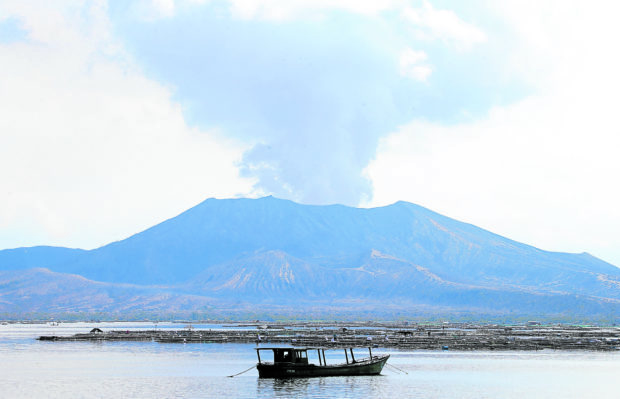
VOLCANO WATCH Residents in communities within the danger zone of Taal Volcano in Batangas province have left their homes to ensure their families’ safety amid the volcanic unrest. Steam-driven plumes are seen on Taal in this photo taken in Agoncillo town, Batangas, on Monday. —NIÑO JESUS ORBETA
MANILA, Philippines — A “short-lived” phreatomagmatic eruption occurred at the main crater of Taal Volcano on Wednesday morning, according to the Philippine Institute of Volcanology and Seismology (Phivolcs).
“At 5:18 AM today, a short-lived phreatomagmatic eruption occurred at Main Crater and generated a grayish plume that rose 300 meters before drifting southeast,” Phivolcs said in its bulletin.
Phivolcs director Renato Solidum told INQUIRER.net in a text message that the latest volcanic activity has “no significant effect on communities farther out of the volcano island as the ash is mainly confined in the main crater and the island as the height of the eruption column at 5:18 a.m. was 300 meters.”
Solidum told a separate interview with ABS-CBN’s Teleradyo that the eruption lasted only until 5:19 a.m.
Phivolcs said in its bulletin that in the past 24-hour period, the Taal Volcano Network recorded 55 volcanic earthquakes, including one “explosion-type” earthquake, 44 low frequency volcanic earthquakes, five volcanic tremor events having durations of two to five minutes, five hybrid earthquakes and low-level background tremor that has persisted since April.
Meanwhile, high levels of volcanic sulfur dioxide or SO2 gas emissions and steam-rich plumes that rose 1,500 meters before drifting southwest was generated from the main crater. Phivolcs said SO2 emission averaged 7,560 tonnes on Tuesday.
“Mataas ito (SO2 emission) at ito ‘yung sinasabi natin na posibleng magkaroon ng mga pagsabog sa Taal Volcano kasi nga mataas ang pagbuga ng sulfur dioxide,” Solidum told Teleradyo, adding that eruptions larger than the one recorded this morning may still occur at the volcano.
(This is high and this is the reason why we say eruptions may occur at the Taal Volcano due to the high level of sulfur dioxide emission.)
Alert level 3 was raised over the volcano after it released a “dark phreatomagmatic plume” estimated to be one kilometer-high last Thursday.
Under alert Level 3, magma extruding from the volcano’s main crater could drive “explosive eruption,” according to Phivolcs.